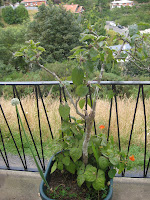As a renter who moves every year by means of a gas station rented trailer, I keep most of my garden perennials in containers and plant out annuals in any patch of ground I can find around the property. This year I have a sunny deck for my container garden! We've had a rainy sunless winter and a summer that hasn't quite broken yet, but that's not too unusual for Dunedin. 30 degrees one day and 12 the next. At least I can grow in the wintertime here. My container Garden consists of 20 litre mayonnaise buckets (classy I know) as well as some 20 litre planters I've gathered from previous flats that were laying around unused. I have a collection of two litre ice cream containers from a fish and chips shop that I used to grow lettuces in too but I've got plenty of space in the garden this year. The pictures on the page are some of the containers that are established.

While not really permaculture, I do use some of the same ideas you would find in a guild in the containers. The polycultures, while bit limited by space, are some of the same you might find in a setup in the ground. the white clover I am so fond of is edible (leaves and flowers and roots) and nitrogen fixing. I gave up on garlic and shallots as root crops but the leaves are tasty and they deter pests. I put beans wherever I can fit them in the containers and around the garden. The fuchsia has edible berries too. Cape gooseberries are perennial if brought in over the winter and are just now flowering. White clover is low growing unlike red clover and grows as a weed around the city( aka. free!). Nasturtiums are tasty (similar to turnips: leaves and flowers) and attract bees. I've read that beans don't like garlic and its relatives but they seem to be pretty happy together. There's usually something always flowering in the containers except in the middle of winter but the bees aren't out then anyway.

There are many companion planting sites that list good matches. Most are repetitive and few are cited scientifically. I find contradictions here and there too. I personally feel its most important to consider that the root shapes are compatible (the roots need to be of varying shapes so they don't compete for nutrients in the same area of soil). There are theories that say some plants deter pests backed with some science. Some may make surrounding plants taste better. I'm not sure of the scientific validity of the latter. I cram as many plants as I can so there's less weeding, might as well go for species that may benefit each other in that way. Soil conditioners like nitrogen fixers are always good. Other plants attract wasps or provide habitat for predatory insects. In little containers that's not too relevant but if you put your container area near a more wild spot in the garden those strategies can be used. Deep rooting plants use
nutrients and bring them up above the soil to build their leaves, these
leaves are useful for mulching container plants. At the end of the day
the more biodiversity (or more species that are not closely related) you
have in the garden the less any one pest should be a problem. If you
have a specific pest problem look up its natural predators and find out
what plants they may eat and what habitat they live and breed in.
Resources:
Wikipedia Page on Companion Planting
No comments:
Post a Comment
Please Leave a Comment